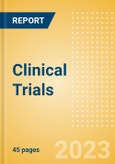This report provides analysis of clinical research involving precision and personalized medicines and identifies trends throughout the years.
The terms precision and personalized medicine are often used interchangeably as they refer to similar types of treatment. They both define the stratification of patients within a disease segment using their genomic and phenotypic variations to find targeted therapies. This is an alternative to the traditional process of drug design, which typically follows a one-size-fits all approach. Precision and personalized medicine is an emerging field that contrasts with the historic concept that patients who present similar symptoms may respond differently to the same medical intervention. Technological advancements over the last two decades have revolutionized the treatment landscape for various therapy areas, particularly oncology indications. This success has encouraged substantial investment in this space as sponsors expand beyond oncology with the intention of replicating this success in other diseases with heterogenous patient populations. This report aims to provide analyses of clinical research involving precision and personalized medicines and identify trends throughout the years.
The terms precision and personalized medicine are often used interchangeably as they refer to similar types of treatment. They both define the stratification of patients within a disease segment using their genomic and phenotypic variations to find targeted therapies. This is an alternative to the traditional process of drug design, which typically follows a one-size-fits all approach. Precision and personalized medicine is an emerging field that contrasts with the historic concept that patients who present similar symptoms may respond differently to the same medical intervention. Technological advancements over the last two decades have revolutionized the treatment landscape for various therapy areas, particularly oncology indications. This success has encouraged substantial investment in this space as sponsors expand beyond oncology with the intention of replicating this success in other diseases with heterogenous patient populations. This report aims to provide analyses of clinical research involving precision and personalized medicines and identify trends throughout the years.
Key Highlights
- Oncology has dominated the research landscape. Companies have witnessed this success and begun utilizing the approach more frequently in other areas such as immunology and CNS, both of which have highly heterogenous patient populations, making them ideal candidates for a precision and personalized approach
- Several countries within APAC have dedicated precision and personalized medicine initiatives that have substantially contributed to the region's dominance. China's PMI was introduced in 2016 and is responsible for launching APAC ahead of North America
- In 2020, infectious diseases hit a record high in precision and personalized medicine trials with 86% concerning COVID-19. Oncology precision and personalized medicine trials hit a record low at that time, indicating that funding was being allocated to COVID-19. Phase I trial initiations also saw an increase as they are cheaper and require the smallest patient cohort, which was desirable during the pandemic
Scope
- The clinical trial data used for these analyses were extracted from the publisher's Clinical Trials Database. The report focuses on precision and personalized medicine trials captured in the database as of June 20, 2023. The data has been analyzed by year, phase, status, therapy area, indication, geography, sponsor type (industry versus non-industry sponsor), reasons for discontinuation, and use of virtual components. An additional analysis on marketed drugs has also been included
Reasons to Buy
- Identifies and dissects trends across clinical trial phases and statuses, as well as regions, countries, sponsors, therapy areas, and indications
- Explores record highs and lows across years, regions, and therapy areas, and offers reasons for this
- Highlights leading therapy areas, indications, geographies, sponsors, and marketed cell and gene therapies
- Spotlights main reasons for trial terminations and emphasises main trial phases terminated
- Discusses the prevalence of decentralised clinical trials and virtual components.
Table of Contents
1 Table and Figures2 Executive Summary6 Key Findings
3 Introduction
4 The Clinical Trial Landscape of Precision and Personalized Medicine
5 Analysis of Cell and Gene Therapies in Precision and Personalized Medicine Clinical Trials
7 Appendix
List of Tables
List of Figures
Companies Mentioned (Partial List)
A selection of companies mentioned in this report includes, but is not limited to:
- National Cancer Institute US
- Fred Hutchinson Cancer Research Center
- University of Texas MD Anderson Cancer Center
- Masonic Cancer Center
- University of Minnesota
- Memorial Sloan Kettering Cancer Center
- Mayo Clinic
- Baylor College of Medicine
- Stanford University
- City of HopeMesoblast
- ImmunityBio
- Anterogen
- Pluri
- University of Texas MD Anderson Cancer Center
- Dendreon Pharmaceuticals
- Sangamo Therapeutics
- Lisata Therapeutics
- Helixmith
- PharmicellEmmes
- PPD
- Sarah Cannon Research Institute
- Medpace Holdings
- IQVIA Holdings
- Reliance Life Sciences
- ICON
- FGK Clinical Research
- Syneos Health
- Rho








